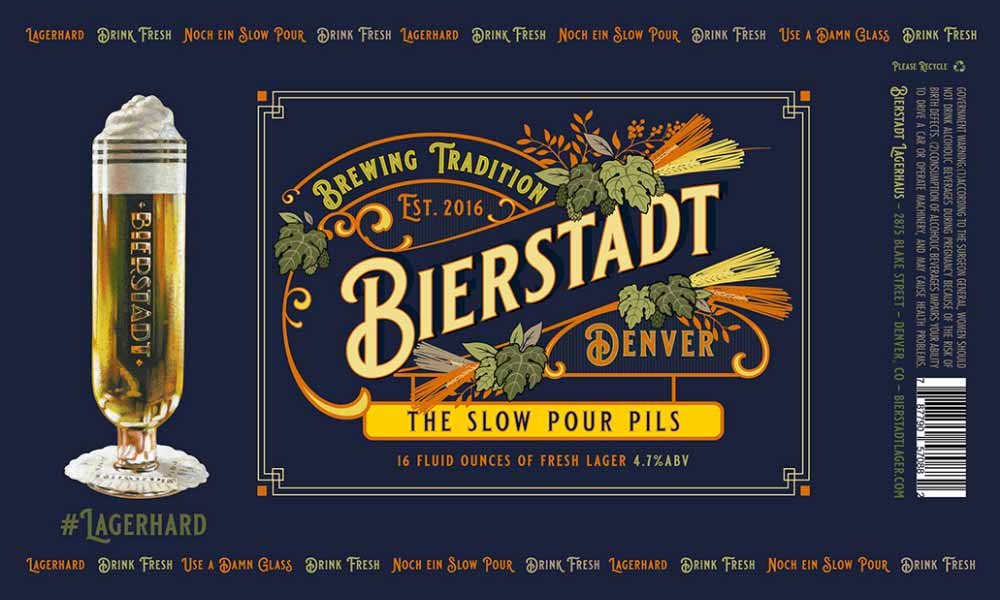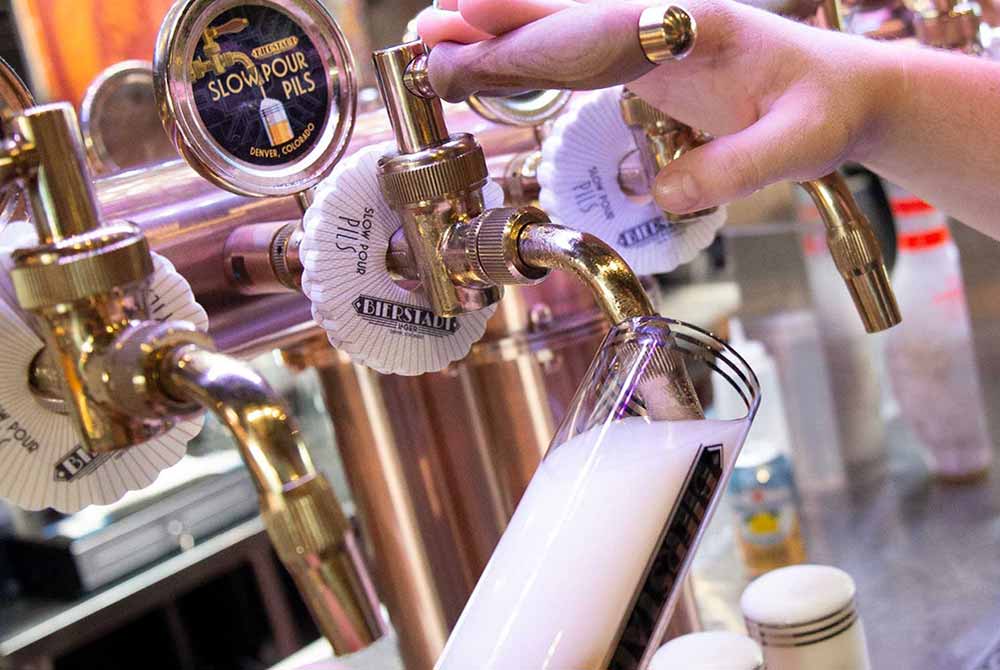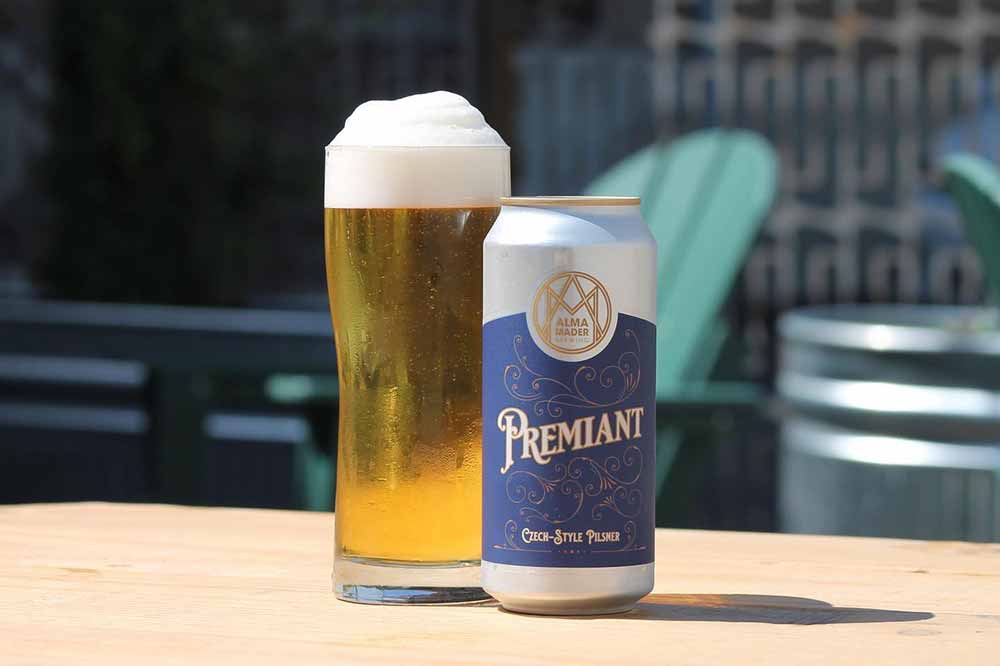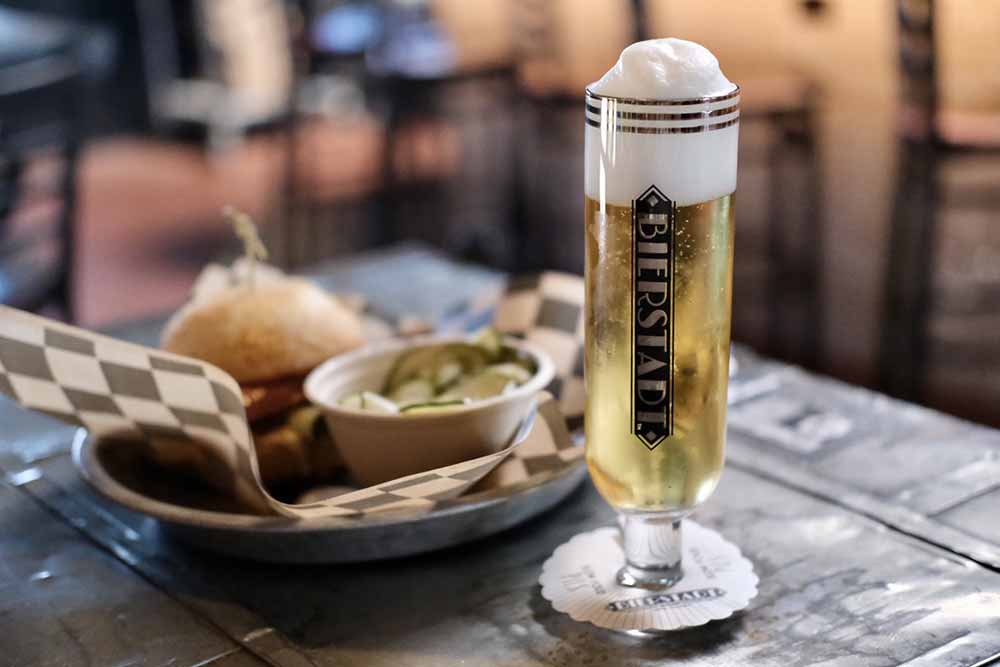Shop
What Is a Slow Pour? And Is It Worth the Wait the Seven Minute Wait!?
Would you wait 7 minutes for a beer?
Other Articles to Read:
I squeezed past a jostling couple, pushing my way forward to the crowded bar. Behind the counter, a mass of glasses seemed to be piling up all in different states. Some with foam settling halfway, others about to peak with a beautiful ice cream-like mound of white clouds on top.
Curious, I asked the bartender, “What is that?”
“It’s our Slow Pour Pils,” they responded.
All around me the words “Slow Pour Pils” spilled out of people’s lips. Before my eyes the number of glasses waiting to be filled stretched longer. It took me only a moment to pause and decide, “I’ll take one of those!”
Roughly seven minutes later, the bartender gingerly placed one of the most beautifully poured beers I’ve ever seen in front of me. With a thick, almost whipped cream-like head of foam cascading over the lip of the glass in a stiff peak, Bierstadt Lagerhaus’ Slow Pour Pils beckoned me forward.
Even before I took the first sip, the aromas of light lemon did a little jig around my nose. Digging in, I emerged with a light white ring of froth on my upper lip. And while my mouth said keep drinking, my brain said ‘What on earth is this?’ What is a slow pour? And how have I never heard of this?
I needed to learn more.
I drank that first Bierstadt Lagerhaus Slow Pour Pils three years ago while visiting Denver for the Craft Brewers Conference.
And it’s only last year that I finally followed up, discovering how one brewery made Slow Pour Pils and conceptualized the entire slow-pour technique.
First, The Difference Between Slow Pour and Slow Pour Pils

Photography courtesy of Bierstadt Lagerhaus
Before we go too far down the rabbit hole, it’s important that we distinguish between a “slow pour” and a “Slow Pour Pils.”
Slow pouring is a technique of pouring beer that can be attributed to Ashleigh Carter and Bill Eye, owners of Bierstadt Lagerhaus in Denver, CO. Both subsequently created the Slow Pour Pils, the actual name for their beer.
You can certainly slow pour other styles of beer. A few breweries have since gone on to slow pour their own pilsner recipes, such as Alma Mader Brewing owned by Nick Mader in Kansas City, MO. But if we’re referring to Slow Pour Pils as a proper noun, that’s Bierstadt Lagerhaus’ version.
“There is only one Slow Pour Pils,” says Bierstadt Lagerhuas Head Brewer and Co-Owner Ashleigh Carter. “Just like there is only one Heady Topper. Just like there is only one Pliny the Elder. That’s the name of our beer and there is no other beer that is Slow Pour Pils out there. Yes, it describes the process, but it is also the name of our beer… Those words were never uttered together in front of the world pils or any beer until we did that.”
Great, but what does the “slow pour” part of “Slow Pour Pils” refer to?
That’s a fantastic question.
And in order to answer it we need to first understand the concept (or lack thereof) around serving beer properly in America.
Stick with us here, we promise it’s important.
In fact, consider this piece a little bit like a slow pour itself. Yes, it’ll take you a bit longer to read, but each layer we build on top of the other. And if you stick with us to the end, we promise your patience will be rewarded.
#ProperGlassware

Most every beer style can be enhanced by being served in a specific glass. Think of it like a cocktail. There’s a reason bartenders serve Old Fashioneds in rocks glasses and Gin and Tonics in highball glasses. The shape, design, and structure of the glasses help promote the aromas and flavors of the drinks inside.
Similarly, a bulbous tulip glass helps accentuate the nuances of Belgian ales while a long stemmed hefeweizen glass encourages the buildup of that essential head in a hefe.
Internationally, great consideration is taken when picking the right glassware. However, here in America, we’ve adopted a shaker pint as the one-size-fits-all glass for all of our beer, regardless of style.
And unfortunately, this glass tends to be a poor vessel to present beer. The sloped sides mean your palms and fingers touch the glass constantly, warming the liquid inside quicker. Plus, that same design prevents crucial head retention from forming.
“It’s crazy because you can go to Australia and get a shitty Coopers poured in a perfect glass with foam, but unfortunately, in this country we adopted the shaker pint for some god awful reason,” says Carter. “We wanted to change that idea of how to present beer and make it special again.”
When Ashleigh and her husband Bill Eye opened Bierstadt, they knew from the very beginning that they wanted to change how people served beer in the United States.
A fan of having her pils poured slowly, Carter set her sights on developing Bierstadt’s own technique.
“That’s the way I like my beer poured,” says Carter. “When we opened this place ourselves we made a conscious decision: Are we really going to make every pils take long to pour? Are we going to do this to the bartenders? We looked at each and said, ‘You know what? I want the customer to have the same experience that I like having.’”
But since American draft systems tend to focus on dispensing beer quickly, Carter and Eye had to look elsewhere.
For the duo, their slow-pour technique began with sourcing a Czech faucet. And using it in a way no one else had.
The American Slow Pour Starts with a Czech Faucet

Photography courtesy of Jamie Bogner | Craft Beer & Brewing
Before opening Bierstadt, Carter worked at a bar that used Celli Italian faucets, a beautiful piece of international beer-dispensing equipment. When she left to open Bierstadt, Carter told herself that she would find something cooler than that.
What did she discover?
A Czech LUKR faucet. Considered a side-pull faucet, the LUKR is used for several different pouring styles in the Czech Republic.
For instance, the hladinka, where bartenders crack the faucet open a bit, put the nozzle at the bottom of a big bulbous Czch pilsner mug, and fill it with foam halfway to two thirds before opening up the faucet all the way to get a clear pour. With the nozzle submerged under the foam, the beer would fill underneath the foam, creating a third to a half or more of foam on top. “It’s this big thick foam they call wet foam,” says Neil Witte, Owner and Co-Founder of Tapstar and Craft Quality Solutions and Master Cicerone. “It’s drinkable, not fluffy, light airy stuff…but when you drink a hladinka you’re getting foam and beer at the same time with every drink, which creates a totally different experience.”
It’s the LUKR’s ingenious design that contributes to this buildup of froth. According to Witte, inside the tip of the faucet there is a screen that filters out any larger bubbles and promotes smaller, finer ones. Combined with a ball valve (as opposed to a plunger valve) that lets you better control the flow of beer, that helps create that wet dense foam.
Something important to Carter and Eye. “We love the way they pour just foam and how they can pour really clean, tight beer too,” says Carter, who called up a random Pilsner Urquell bar in NYC to figure out where to find these LUKR side-pull faucets. “We sent $12,000 dollars into the ether not knowing if we were going to get anything back,” says Carter.
Lo and behold, the LUKR faucets showed up.
But instead of following traditional Czech technique, Carter and Eye created their own spin on a pouring technique—the slow pour.
And they did so unashamedly. “I like this idea in the United States of developing our own new things,” says Carter. “I use the faucets for whatever the hell I want and I am not ashamed of it. I got to start my own brewery and do whatever I wanted to do.”
After all, it’s ingenuity that pushes the frontier of any industry forward, right? That and a little bravery and grit.
So, What Is the Technique of Slow Pouring?

Photography courtesy of @almamaderbrewing | Alma Mader Brewing
A slow pour is a technique of pouring beer with a side-pull faucet.
The overall idea is to create layers of foam that build on top of each other. Something that can only be done slowly through a series of around three to four pours in the same glass.
We’ll break it down for you by pour.
The first pour should be about half beer and half foam (or two-thirds beer and one-third or more of foam depending on the glass). Carter and Eye actually have special Bierstadt-branded glasses used only for their Slow Pour Pils (which is a story in and of itself for another time), so she instructs her bartenders to pour between the ‘R’ and the ‘S.’
But no matter what type of glass you’re using, “the first pour is really the most important,” says Nick Mader, co-founder of Alma Mader Brewing who slow pours his Czech pils called Premiant out of his taproom. “Set that foundation right and you can stack the foam while your liquid level comes up.” You need to create that nice tight base, because if you don’t get the first pour right, you’ll mess up the entire slow pour.
Before adding more beer into the glass, the foam needs to settle. Remember that lineup of glasses at Bierstadt I noticed? They’re all taking a second to chill, letting the wet foam pack into a dense cloud. “Over time, that foam will settle down and then you start topping up with more and more, almost like a cappuccino,” says Mader.
For the second pour, “you should start to see the head condense on itself and form this beautiful rocky top,” says Carter.
While during the third pour, you add beer until you see the “foam rise above the glass like a root beer float,” says Carter.
Witte adds, “As you continue to pour, each time you push the foam up a bit further, and when you do it the right way you can see these beautiful ice cream cone heads with different layers…that stick way up over the tip.”
All told the process can take anywhere from five to seven minutes.
This controversial waiting period gives the slow pour its name. And also its polarizing popularity.
Begging the question: Is the slow pour worth the wait?
Ask Carter, Mader, or Witte and you’ll get a resounding yes. (And for the record, if it’s not clear yet, we whole-heartedly agree).
The Benefits of Slow Pouring: Presentation

Photography courtesy of Ashley Knotek | Bierstadt Lagerhaus
We drink with our eyes first, right? So even if folks aren’t quite sure what a slow pour is, they’re intrigued to find out more.
“Obviously the presentation is rad,” says Carter. “You just look at this thing and want to drink it.”
Mader agrees that the appearance of “decadent foam and great lacing down the side of the glass” alone has people in his tap room lining up to try the slow pour.
“In the tasting room, the slow pour pils are a showpiece,” says Mader. “They’re eye-catching.”
It’s exactly what happened to me when I first ordered a Slow Pour Pils at Bierstadt.
And lo and behold, it happened to Witte too. “I’d sit at Bierstadt [and see this] really cool and genius thing that people lined up for,” says Witte. “What is the deal with this slow pour?”
It’s a conversation starter that automatically draws people in wanting to learn more.
But in addition to a beautiful showpiece, the slow-pour technique also has practical benefits for the beer.
“For me, slow pour is a different presentation; it’s eye catching and it elevates and celebrates these elements of well-made beer often overlooked—like foam structure,” says Mader.
After all, do you think that Cumulus cloud on the top of your glass is just for show?
The Benefits of Slow Pouring: Foam, Foam, and More Foam

Photography courtesy of Alma Mader Brewing
Of course, the core component of the slow pour is building that incredible head retention.
And for a beer, foam is truly your friend. (For those who may think foam equals shitty beer, think again.)
All the incredible aromas of a beer are locked inside of the foam. So for many brewers, a good beer has a great foam.
“I look at foam structure in a lot of beers…as a quality attribute of the beer,” says Mader.
Carter agrees, pointing out that “beer is the only beverage that makes this huge foam… The foam is a part of what beer is.”
In fact, in the Czech Republic they even have a pour called the mlíko or “milk pour” which fills the entire glass with only wet foam. It’s another pouring technique courtesy of the Lukr side-pull faucet. “You get a glass full of foam, but you can drink it and it changes the whole complexity of the beer,” says Witte.
Foam should flourish in a beer, and slow pouring is a great way to create a pretty fantastic fluff.
But even underneath that spume, a slow pour can affect the actual liquid as well.
The Benefits of Slow Pouring: Carbonation

Photography courtesy of Britt Antley | PorchDrinking.com
For Carter and Eye at Bierstadt, their Slow Pour Pils is actually a pretty highly carbonated beer. According to Carter, those zesty bubbles can be a bit harsh on the palette, but they’re necessary for that good head retention. “By slow pouring, you dissipate some of that carbonation,” says Carter. “It softens the beer in a really incredible way.”
It’s something Witte noticed right away: “It took some of the sharpness out, that prickle on your tongue that helps to accentuate bitterness in beer, so the beer comes across sweeter when the carbonation knocks out.”
Similarly, Mader carbonates his Czech-style pils Premiant at a high level. “But when we do a slow pour, it knocks out some of that carbonation…that accentuates the malt profile more than a ‘fast’ regular pour.”
All of the above reasons come together to create one pretty epic drinking experience.
The Benefits of Slow Pouring: The Consumer Experience

Photography courtesy of Bierstadt Lagerhaus
Mader likes to describe a slower pour as “an experience pour.” You’re not just signing up to drink a beer, you’re basically investing in a new pouring process that, yes, will take longer, but ultimately in the end will lead to a better beer.
And in an age where it seems like Amazon can ship our packages in one day (and we get angry if we can’t read an article in three minutes)…maybe taking a step or two back to wait for a slow pour is a good thing.
“In the U.S., we’re so used to quick transactions, so having the patience behind a pour is something to celebrate,” says Mader.
Don’t get us wrong. We’re not putting this all on the consumer. The slow pour has also forced brewers to take a step back.
But not everyone is a fan of it.
Will People Really Wait 5-7 Minutes for a Beer?
Yes and no.
Without a doubt, slow pours can be polarizing.
“Some people think it’s ridiculous and some people think it’s amazing,” says Mader, noting that regardless of whether people like it or not, it always grabs their attention. “I wanted people to ask: What is that?”
They have certainly asked and asked and asked again.
According to Carter, she’s seen a slew of responses. Some people still slide the foam off into the well or on the floor. “It’s awesome because it has incredible head retention even as foam on the floor,” laughs Carter.
But overwhelmingly, “the first thing a lot of people do is take out their camera,” says Carter.
Similarly, Mader points out that slow pouring his Czech pils Premiant on their LUKR faucet is “without a doubt getting more people into drinking lager beer in our tasting room,” says Mader. “Overall that’s a great thing, especially because we’re proud of it.”
Mader optimistically hopes that whether people jump on board the slow pour train totally, the technique at least has helped folks in his neighborhood turn their attention to lagers.
What Is the Future of Slow Pouring?

Photography courtesy of @almamaderbrewing | Alma Mader Brewing
For Mader he says that he’s looking at the overall picture. Thanks to slow pouring his pils, Mader has been able to convert more Midwesterns to drinking lagers. He considers that a huge win.
“If in ten years we look back at the slow pour and determine that they’re nothing more than a statement piece or fad, that’s fine because what’s happening right now with lager is a great thing for craft beer,” says Mader. “I think that any moment we have to celebrate beer-flavored beer is worth the wait.”
Carter hopes that the trend she started won’t only catch the eye of consumers, but of more brewers and bartenders as well, encouraging them to bravely tackle new frontiers.“I’m hopeful that people won’t just apply the technique of slow pouring but use this as an opportunity to present all of their beers better,” says Carter.
It’s that overall dedication to glassware that Carter hopes the industry appreciates that more, whether it’s with a slow pour or something else.
“We decided this one thing is really awesome, but how can all of beer together elevate itself?” says Carter. “I don’t mean in a wine-snooty-do-you-smell-red-currants bullshit. No! Just in an appetizing, beautiful presentation way. A glass that accentuates the best parts of the beer.”
So go get yourself a slow poured beer. We promise the experience is worth the wait.
A Couple of Our Favorite Slow Pours to Try

Photography courtesy of Bierstadt Lagerhaus
Slow Pour Pils – Bierstadt Lagerhuas
Denver, CO
An OG for a reason, Slow Pour Pils is an absolute must-try if you’re looking for a classic slow pour. Read the recipe and this beer may seem simple—just Barca pils malt and Hallertau Mittelfruh hops—but dig deeper and you’ll see that this is a labor of love.
“This is very much a technique drive beer,” says Carter. She deploys a short seventy minute hop at the beginning, a single decoction, and a flotation tank, which is an old-school piece of German equipment before lagering the beer and lastly “filtering the shit out of it,” says Carter. “I believe beer should be bright, especially lager beer.”
The result if a beer that has a wonderful lightly lemon hop aroma and clean, crisp bit. When it’s slow poured that’s when the magic truly happens.
We highly recommend you visit the brewery’s taproom in Denver to experience Slow Pour Pils (and it’s incredible thick, fluffy head) right at the source. But if you can’t travel, Carter also worked extremely hard to dial-in this recipe for cans.
Premiant – Alma Mader Brewing
Kansas City, KS
Considered a Czech-style pilsner, Premiant features all Czech malt and all Czech hops—mainly Saaz. “It’s a beer on paper that looks seemingly simple,” says Mader. But again, the devil is in the details with this beer with Mader even treating their Kansas City water to mimic a Czech water profile.
Accordingly, Mader says that on average this beer takes six to seven weeks to make Premiant.
But it’s worth the effort. “It’s the beer that everyone loves brewing and drinking at the brewery,” says Mader.
Premiant hits all those classic Czech pilsner notes—crispy, effervescent, and snappy—while finishing a touch drier. “It’s a bold beer,” says Mader. “We pull out herbal, floral, lemon, and something that reminds us of Buddha’s hand.”
From the first sip you’ll be hit with an assertive noble hop character that follow through wiht a nice light honied bread and finishing dry. “For me a tiny bit of lingering bitterness gets me ready for the next sip,” says Mader. “My palate needs it…let’s go!”
And while again, we highly recommend you venture straight to Alma Mader’s taproom to try a slow pour Premiant, Mader does also can this beer.




